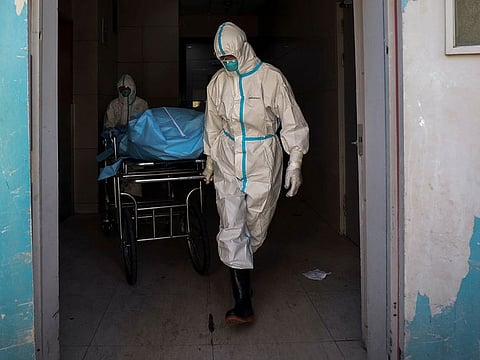In China’s war on coronavirus, a community is besieged
Newness and isolation of Zuoling proved to be weakness, depriving residents of supplies

Wuhan, China: When the coronavirus emerged in Wuhan, residents in a rising suburb on the city’s rural edge thought they were safe. Zuoling New Town, a bustling community of retired farmers, factory workers and young, white-collar professionals, was 22 miles from the market where the outbreak appeared to have arisen. The apartments had sprung from former farm fields, far beyond the alleys of old Wuhan.
But as the virus spread, Zuoling emerged as a stubborn hot spot of infections in Wuhan, and a sombre lesson in how the state’s vast effort to contain the virus left some communities acutely vulnerable. The leadership’s top-down campaign relied on grassroots mobilisation, and the very newness and isolation of Zuoling proved to be a weakness, depriving residents of food supplies, medical care and labour during crucial weeks.
Residents crammed into the only large supermarket to stock up. Those worried about fevers crowded the local, government-run clinic, and many were sent back to their high-rise homes, sometimes spreading the virus. The nearest major public hospital assigned to take patients was 16km away, making it more difficult to get treatment, especially without a car.
“I never imagined that this would hit our home,” said Zhang Jin, a 47-year-old resident of Zuoling. His mother, Yan Yinzhen, who was living with him, contracted what doctors believed was the coronavirus, possibly from a neighbor. Zhang, his wife and father all later fell ill.
“We’ve lost confidence,” said Zhang, a school bus driver. “Nobody in the neighbourhood took charge.”
Stumbling responses
The coronavirus has formed an insidious threat that medical authorities worldwide have struggled to tame. Italy, Japan, South Korea, the United States and other wealthy societies have stumbled in their responses.
For China, the long-term repercussions may be greater, given the size of its outbreak and the bleak contrast with assurances from the national leader, Xi Jinping, that the Communist Party was a robust shield providing “holistic security.” Officially, the virus has infected almost 80,000 people and killed about 2,700 across China, mostly in Hubei province and its provincial capital, Wuhan.
While China’s efforts appear to have slowed infections, a reconstruction of the epidemic in Zuoling - based on over a dozen interviews as well as hundreds of pages of government documents, reports and online accounts - shows how the containment campaign suffered from confusion and discord at the local level, turning unlucky and ill-prepared communities into trouble zones.
There were not enough masks, disinfectant or sanitation workers. Patients suspected of having the virus were confined to their homes, allowing the pathogen to spread. When people were eventually moved to isolation sites, residents initially found that promised care was missing.
On the first day of February, Zuoling New Town had 11 cases, according to community records. A week later there were 79. By February 11, the number of confirmed infections was 116, including four deaths.
‘Don’t tell residents’
Zuo Jinjin learned that the virus had reached Zuoling on January 19, when he and other community workers were ordered to guard the home of a woman suspected of being infected. The 69-year-old woman had been taken to a hospital, while her husband waited in quarantine in the apartment.
A Communist Party official in charge of the area gave the team another mandate: Don’t tell residents much about the case for fear of sowing panic before the Lunar New Year; a general warning would suffice.
“There was discussion about what if this was publicized everywhere, when the New Year was arriving,” said Zuo, a 31-year old employee of the Zuoling community office, the government’s grassroots administration. “There was publicity asking residents to wear masks, but many people didn’t take notice of that.”
Zuo said his wife, a nurse, told him as early as December about a mysterious virus striking people in Wuhan. But city leaders had encouraged confidence that the virus was not highly contagious and that the outbreak was likely to peter out. In Zuoling, officials did little to initially warn residents.
“Back then, there weren’t enough reports about it, and it hadn’t grabbed the attention of all Wuhan residents,” Zuo said. “We believed, me included, that it was a little flu and would be OK - until people were dying.”
The alarm level jumped on Jan. 20, when officials disclosed a burst of 136 infections across Wuhan in two previous days. News reports noted that many victims were linked to the market.
“At that time, we heard that it came from eating wild game, and we didn’t eat that,” said Li Wangjiao, a resident of Zuoling who is also a housing manager there. “I never expected it would come to the edge of Wuhan.”
Three days later, Li’s daughter developed a fever. On that same day, Wuhan barred people from leaving in a bid to stifle the outbreak.
‘People’s war’
As infections multiplied, Xi mobilised the party to lead a “people’s war” against the epidemic. In Zuoling and many other areas, a front-line force was the party’s neighbourhood offices.
These local bodies in China are much more powerful than voluntary neighbourhood associations in many Western countries - and in the crisis, they took on more authority. They were assigned to monitor residents for signs of illness, screen them for treatment and quarantine, and bolster residential checkpoints to guard against outsiders who might bring in the virus.
Zuoling seemed ill-prepared. Often, new suburban areas have not accumulated the same labour force, experience and resources from the state as older neighbourhoods, said Benjamin Read, a professor at the University of California, Santa Cruz who studies local politics in China.
“With a mission like maintaining quarantine, they are dealing with a complicated set of ongoing tasks,” he said. “Any lapse at any time could undermine the containment of the epidemic.”
Many maintenance workers and guards for housing management companies in Zuoling quit as worry about the virus grew, leaving them short of employees to disinfect and clean, said residents and security guards. These poorly paid employees typically received little protection or training for the risky work.
“Some property management quit as it’s too dangerous. It was just a few people without any protection to go around the compound,” said Yan Yanbin, an apartment guard in Zuoling who developed a fever and other signs of coronavirus infection. “Checking temperatures became a charade; the thermometers didn’t work.”
Community health workers to the rescue
As hospitals across Wuhan were swamped by patients, the government said on Jan. 23 that neighbourhood health centres would be the first defence against the coronavirus.
Community health workers are usually not well paid and have fewer qualifications than hospital doctors. Now they stepped forward as triage workers, screening people for fevers, and dispatching patients who might have coronavirus to the bigger hospitals.
The Zuoling community medical centre, opened in 2017, was clean, modern and had 99 beds - enough for normal times but too little for the surge of hundreds of patients every day.
“Beds were extremely tight, and the community tried to do what it could to find spots,” said Zuo, a worker for the Zuoling neighbourhood administration. “We did everything we possibly could, but because there just weren’t the beds, they just had to go home.”
Feeling of relief
New orders had gone out across Wuhan: Patients who were sick or suspected of having the virus would be moved from their homes to makeshift quarantine sites opened in hotels, dormitories and even a convention centre.
Many residents of the city, like Yuan Jiaxiang, a 41-year old engineer suffering from a high fever, felt relief that they could end waiting in their homes. But many of the requisitioned hotels strained initially to care for the masses of weak, feverish patients.
“There was no treatment at all, simply locking down the patients,” Yuan said of the hotel where he spent five days. “I felt kind of disappointed at that point, and this constant fever didn’t get proper treatment.”
Officials had seen early on that sending patients home, or holding them in crowded local fever clinics, increased the risks of the coronavirus lingering in communities. In early February, the government had created a plan to take potentially infected people from their homes, but the policy faltered for lack of spaces for patients.
After a renewed push from the following week, growing numbers of mild cases were sent to cavernous sports and convention centres crammed with rows of beds. Patients who had not been tested but showed symptoms were sent to dormitories or hotels turned into makeshift wards.
‘Chaotic organisation’
The transfers happened with such urgency that safety was sometimes ignored. Patients who had waited many days at home for a hospital bed were rounded up at night by community workers and put aboard buses.
“The organisation was chaotic,” a report from Xinhua, the official news agency, said of one transfer. “The outcome was patients losing control of their emotions after being kept waiting for a long time.”
Patients sent to hotels sometimes found that their families could not send them medicine or food. And hotel workers, often scarce and scared during the crisis, could not keep their rooms clean. “The beds were clearly not enough, and disinfection of the isolation sites was not timely,” said a report by Wuhan city inspectors who visited Zuoling.
Conditions have improved as more aid has poured into Wuhan and the number of infections has fallen. Despite concerns about the risk of infection in quarantine sites, many patients said they felt safer there.
“It’s not as depressing here,” said Yuan, the engineer, who was moved from the hotel to a large quarantine site - a commandeered exhibition centre - after he was diagnosed with the coronavirus. “There are people to talk to, so I think it’ll be easier to pass the time.”
Sign up for the Daily Briefing
Get the latest news and updates straight to your inbox




![Facility temporarily closed as authorities probe safety lapses. [Illustrative image]](http://media.assettype.com/gulfnews%2F2025-12-19%2Fgzzcwfvh%2FSauna.jpg?w=320&auto=format%2Ccompress&fit=max)


